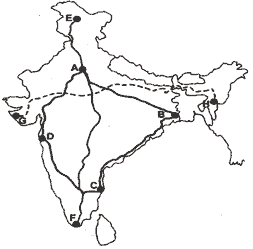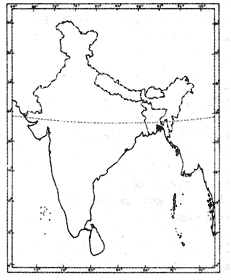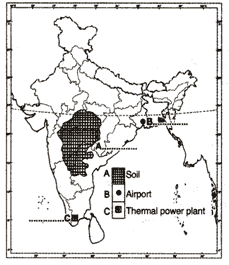Q. 1.* Name the Chola temple in Thanjavur. What is the most striking feature of this temple? 2
Q. 2.* Mention any two main characteristics of Mughal paintings of Akbar and Jahangir’s time. 2
Q. 3. Mention two types of resources. Give one example of each. 1+1=2
Q. 4. What are reserved forests? What is the percentage of total forest cover under this category? 1+1=2
Q. 5. Mention three major sources of irrigation in India. Which source of irrigation is more popular in the southern States? 1½+½=2
Q. 6. Give two points of difference between renewable and non-renewable resources. 2x1=2
Q. 7. How does deforestation affect eco system? Give two examples. 2
Q. 8. Study the map given below, showing national highway development project and answer the questions that follow: 1+1=2

(8.1) Name the expressway national highway that will join A, B, C and D stations.
(8.2) Name the cities related to C and D stations.
Note: The following question is for the Blind Candidates only in lieu of Q. No. 8:
Give two characteristics of North-South Corridor.
Q. 9. Define economic and non-economic activities and give one example of each. 2
Q. 10. How does rapid growth of population create unemployment? Give any two points. 2
Q. 11. Explain the term ‘poverty’. 2
Q. 12. Explain briefly the two approaches by which the number of the poor in the country is estimated. 2
Q. 13. What does ‘health’ mean? Explain briefly. 2
Q. 14. Explain the contribution of M.G. Ranade to the Indian awakening. 4
Q. 15. What were the common features of socio-religious movements that emerged in 19th century India? 4
Or
Examine the role of various Muslim reform movements in India in the 19th century.
Q. 16. How do physiographic and economic factors influence the distribution pattern of Indian railway network? Explain with suitable examples. 2+2=4
Q. 17. Explain any four causes of poverty. 4
Q. 18. Describe any four factors which perpetuate gender inequality in India. 4
Q. 19. “Terrorism poses a serious law and order problem and leads to the disintegration of society.” Justify the statement giving four example 4
Q 20* Evaluate the influence of socialistic ideas on the Indian National Movement. 6
Q. 21. What is the importance of coal as a source of energy and as a source of raw material? Describe in brief the distribution of coal in India. 2+2+2=6
Q. 22. How have the technological and institutional reforms been able to improve the condition of Indian agriculture? Explain with suitable examples. 3+3=6
Or
How is biotechnology beneficial to the farmers? How is it able to maintain sale and sustainable environment? Explain with suitable examples. 3+3=6
Q. 23. Why are jute mills concentrated along the Hugli river? Explain giving any six reasons. 6x1=6
Q. 24. Describe any six features of Indian Economy. 6
Or.
Describe any six measures of liberalisation taken by the Government of India. 6
Q.25. Explain how the public distribution system and administrative price mechanism help in controlling price rise. 6
Q. 26. Examine the provisions incorporated in the Indian Constitution for the protection and development of children. 6
Or
“Corruption is a hindrance in the development of a country.” Explain. 6
Q. 27. (a)* On the given outline map of India mark with their names any two places of revolts from 1763 to 1852 in India. 2
Note: The following question is only for Blind Candidates in lieu of Q. No. 27 (a):
*point out any two defects responsible for the failure of Cripps Proposals of 1942. 2
(b) On the given outline map of India, locate and label the features given
below:
(i) Mathura Oil Refinery
(ii) Rawatbhata Nuclear Power Plant
(iii) Rourkela Iron and Steel Centre 3 x 1=3

(c) Study the map given below and identify the features marked as A, B and C and write their names correctly in the space provided: 3x1=3

Note: This question is for the Blind Candidates only in lieu of Q. No. 27 (b) and (c)
Q. 27. 1. Name the oil refineries located in Haryana and Bthar States. 1
27.2. Name the nuclear power plants located in Uttar Pradesh and Karnataka States. 1
27.3. Name the iron and steel plants located in Chhatisgarh and Orissa States. 1
27.4. Name the Software Technology Parks located in Jammu & Kashmir and Kerala States. 1
27.5. Name the two major jute producing States of India. 1
27.6. Name the two major ports located in Gujarat and Andhra Pradesh. 1